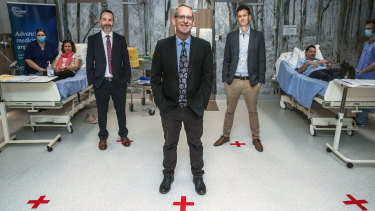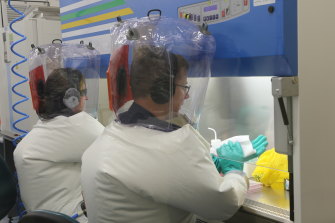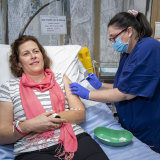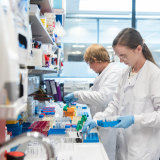
Drew and his team believed they were as well prepared as anyone in the world to set up a vaccine “pipeline” for rapid pre-clinical trials in the event that a “Disease X” broke upon the human population. No-one knew excatly what Disease X might look like. But CEPI and the WHO had become increasingly worried about the potential for an unknown pathogen to emerge that could spark a future epidemic.
Drew and his team succeeded in their pitch and won their first tranche of funds from CEPI, but rather than war-gaming the hypothetical Disease X, they found themselves going into battle against SARS-CoV-2, the deadly new coronavirus which had broken out of Wuhan, China, in January this year.

Professors Trent Munro and Keith Chappell with Professor Paul Young (centre), who co-leads the team at the University of Queensland producing what looks like Australia’s leading candidate for a coronavirus vaccine.Credit: University of Queensland
The team’s secret weapon was ferrets. The centre had been working with the creatures for many years, originally in the context of earlier viruses like SARS, an older but less infectious cousin of SARS-CoV-2. “It just so happens that the cells in the lungs of ferrets display many of the same sorts of proteins on their cell surface that we see in humans,” says Drew. “It meant we already had in place a pre-clinical trial pipeline.”
Pre-clinical trials in animals help determine safety and track immune responses, and are a crucial step towards trialling vaccines in humans. Thus, when CEPI and the Oxford team were looking for somewhere to conduct early animal trials on the British vaccine contender earlier this year, they came knocking on CSIRO’S door.
Drew and his team have been working 12 hours or more a day since. With global infections now heading towards 20 million, economies on their knees and thousands dying daily, the stakes could not be higher. “We were going to go on a sprint, then it turned into a marathon and now its more like a tour de France,” Drew says.
His team have had two big Eureka moments. The first was when they found they could replicate SARS-CoV-2 in their animals. And the second was when they were able to see clear differences between the ferrets that had been vaccinated, and those that had not. They are now experimenting to see if putting the vaccine directly into the nose instead of into muscle might have advantages for the protection of the lung surface.

The CSIRO’s high-containment biosecurity facility, the Australian Animal Health Laboratory, in Geelong.
While their results were fed back swiftly to the Oxford team (who have teamed up with commercial partner AstraZeneca), Drew’s researchers were also helping to assess another promising vaccine candidate being worked up by Inovio, a US company. And CSIRO has another finger in the pie, assisting the leading Australian candidate for a vaccine being produced by the University of Queensland.
So frenetic has the race for a vaccine become that The New York Times’ Coronavirus Vaccine Tracker currently identifies 165 potential vaccines under development, of which 28 have progressed to human trials.
Last month, the results of the Oxford trials were released in the journal The Lancet, showing that tests on 1077 healthy adults had proven safe, and triggered a strong immune response, mobilising both antibodies and T-cells, vital parts of the body’s defence system.
The Oxford vaccine is now moving into widescale “phase-3 trials”, beginning with administering doses to thousands of people in Brazil, South Africa and the US to see if they acquire immunity in real-world environments where COVID-19 is rampant. The Oxford team leader, Sarah Gilbert, says she hopes to have proof of efficacy by September, and there is talk of some people receiving the vaccine as early as December if the stage-3 hurdle is cleared.
Phase-3 trials are the acid test for all the vaccine candidates. It's a benchmark that usually takes years to reach. But unprecedented global collaboration between different research communities, huge funding commitments by governments, big pharmaceutical companies and outfits like CEPI, together with the sheer urgency of the task, have compressed the timeline. Years’ worth of work is being accomplished in months.
Yet Brisbane-based professor Paul Griffin warns that even with perfect phase-1 or -2 results, “vaccines can fall over at that last step. That’s why there is so much parallel activity - it is just too early to say which will get all the way there”.
That caution is shared by Professor Paul Young, who co-leads the team at the University of Queensland producing what looks like Australia’s leading candidate for a coronavirus vaccine.
“The reality is that we have a lot of history over the last few decades of potentially exciting vaccines making their way all the way through phase-2 clinical trials, only to fail in phase-3,” says Young. “We just don't know at this stage.”
Yet Young, and Griffin, along with most of the scientists the Herald and The Age spoke to this week, remain guardedly optimistic, despite WHO chief Dr Tedros Adhanom Ghebreyesus’ downbeat assessment that “there’s no silver bullet at the moment, and there may never be”.

CSIRO's Australian Centre for Disease Preparedness director Professor Trevor Drew.
Griffin is the medical director of Melbourne-based Nucleus Network, the country’s leading specialist in phase-1 clinical trials. He believes “we will have at least one, if not a few, that will be at least moderately effective”. He defines moderately effective as “giving partial protection, or perhaps working in some and not others, or not preventing disease but ameliorating it”.
CSIRO’s Trevor Drew is hopeful of a first tranche of vaccines that “will not be perfect. But provided they give some level of protection and prevent deaths, that will be regarded as a success in the first phase”. He believes “second-generation and maybe third-generation vaccines” could follow, and that “we might in future be having annual combined flu and COVID-19 vaccines. This is very much in the future, but I am cautiously optimistic”.
Mark Sullivan knows from firsthand experience in HIV research that vaccine aspirations often end in failure. Yet Sullivan, an honorary professor at UNSW who heads not-for-profit outfit Medicines Development for Global Health, classes himself as “very cautiously optimistic”.

Helen Sullivan is one of two volunteers who were the first to be given a COVID-19 vaccine candidate developed by UQ.Credit:University of Queensland
“It’s looking more encouraging than not, but my view is always tempered by the fact that … the US FDA has [only] 97 vaccines approved for human use, which is the sum total of 220 years of vaccine research. That's all we’ve got - and those vaccines cover just 30 different diseases,” he says.
Australia's acting chief officer Professor Paul Kelly talked on Friday of "really strong optimism" while adding the rider that "we have never had a vaccine for a [human] coronavirus in the world before".
Young is hoping that his UQ team’s vaccine will ultimately make it to large-scale manufacture in Australia in partnership with Melbourne-headquartered CSL Limited, now a global leader in biotechnology.
The UQ vaccine deploys a protein made to look like the coronavirus “spike” – the club-like protrusions on the outside of the virus that allow it to bind to specific receptors on the surface of cells in the respiratory tract.
Young’s team has developed a unique molecular “clamp” to hold the injected protein in a shape most likely to be recognised by the immune system, provoking what they hope will be a strong targeted immune response. His team too had successfully tapped into CEPI funds well before the advent of COVID-19, giving them a headstart locally.
The UQ candidate has now gone into early human trials in 120 volunteers in Brisbane and Young hopes for a full data set by October, so they can move to stage-2 testing. The pressure, he says, is mounting.
“We are always asked ‘when this is going to be available’ and we have to keep reminding people that there is no given on this. And the 'when' is probably later than everyone hopes for. But it is still likely to be a record for any vaccine,” Young says.
Paul Griffin’s Nucleus Network is carrying out both the UQ phase-1 trials, and early stage testing for another vaccine contender, produced by US biotech giant Novavax.

Dr Paul Griffin was part of the team running the COVID-19 clinical trial for Novavax.Credit:Justin McManus
Novavax became the bearer of encouraging news this week when it announced that its trials in 130 volunteers in Brisbane and Melbourne had shown “neutralising” antibodies at levels four times greater than in a group of patients recovering from COVID-19 itself.
But why would a US giant come to Australia for phase-1 clinical trials? Griffin says several factors make Australia appealing, among them an excellent health and research ecosystem here, some regulatory advantages over the US, and (until recently in Melbourne) a low prevalence of COVID-19, which is necessary in earlier phases of vaccine testing.
Elsewhere around the country, a team at Flinders University, under the leadership of Professor Nikolai Petrovsky, also has phase-1 trials underway in Adelaide.
And at Monash university, a team under Professor Colin Pouton is working up a vaccine candidate (not yet at trial stage) using messenger RNA or mRNA, a revolutionary approach for vaccines. Unlike the UQ and Novavax candidates, which are known as ‘subunit’ vaccines because they rely on the introduction of proteins which look like parts of the virus, the Monash approach relies on a nucleic acid to instruct the host’s own cells to start making something that resembles the spike protein, to kickstart an antibody response.
Local manufacturers have no experience of the technology, Pouton says, and Monash is seeking more funding to progress the work. “From an Australian perspective we need to get on board with mRNA technology and start building the capability of industry to take products forward,” he warns.
Despite the zeitgeist of scientific co-operation, there is still a strong risk of “vaccine nationalism” breaking out. Wealthier western countries are rushing to pre-order millions of doses of potential vaccines , with the UK alone ordering 250 million shots from a range of companies, including GlaxoSmithKline, France’s Sanofi, Germany’s BioNTech and the Oxford/AstraZeneca team.
The US has struck a $2.7 billion deal for 100 million doses of a Pfizer vaccine candidate, under its “Operation Warp Speed” program, aimed at delivering 300 million doses of a COVID-19 vaccine in 2021.
National prestige also comes into play, with Russia claiming it has a vaccine that will be ready to go into production in September. But western scientists are dubious, fearing that Moscow may be taking safety shortcuts.
Prime Minister Scott Morrison warned on Friday that "whoever finds this vaccine must share it" and that any country that had found a winning formula and not made it available around the world would be "judged terribly by history".
Yet even if phase-3 testing proves the efficacy of any of the vaccine candidates, moving to mass manufacture presents a fresh set of challenges.

Members of the Oxford University team responsible for efforts to develop a COVID-19 vaccine.
“The ability to make vaccines in quantity is technically very challenging,” warns Mark Sullivan. “Scaling up from small batches to larger batches often involves multiple testing facilities and that requires a lot of expertise. Also there are other steps that need to be resolved, such as freeze-drying, formulation, packaging and presentation and each decision comes with the need to confirm how stable the vaccine is in shipping, storage and use.”
A recent review for ministers done by Australia's Chief Scientist Alan Finkel and an expert team from the Australian Academy of Science warns that: “countries that can manufacture vaccines are likely to prioritise supply for their own populations. In Australia, only CSL has facilities to support end-to-end manufacturing of protein vaccines and most vaccines and therapeutics are and will continue to be manufactured offshore”.
CSL told the Herald and The Age that “collaborating with UQ in support of their COVID-19 vaccine candidate program is CSL’s priority” and that “while there is a long way to go, early progress is showing promise”.
The company added that “in parallel to our work with UQ we are exploring ways to support the manufacture of other vaccines under development, that match our existing expertise and technical capabilities”.
But Sullivan thinks there has been too much of a fixation on vaccines here, with not enough focus on research into therapies for COVID-19 sufferers. “In Australia, more than anywhere else, we are talking vaccine, vaccine, vaccine and I think it's concerning we have put so much of our hope into vaccines, which is great if we get one,'' he says.
''But we need an emphasis on therapeutics as well. Most infectious diseases are managed with a combination of different … approaches and I expect this one will be no different."
The Australian Academy of Science identifies more than 300 potential therapeutic treatments for COVID-19, of which around 200 are at the clinical-trial stage. These include trying to repurpose existing drugs which have been effective in fighting other diseases and plasma therapy which uses blood plasma from recovered COVID-19 patients to ease symptoms in those battling severe infections. CSL currently has a strong stake in plasma investigations with a potential product under development at its Broadmeadows factory.
Professor Heidi Drummer, head of the disease elimination unit at the Burnet Institute in Melbourne, says even with a vaccine, there remains the risk of “escape mutants” – iterations of the virus that have evolved to evade the body’s immune system.
“How long will immunity last?” she says. “We just don’t know enough about it yet to understand that. This virus is not going to go away, it's in the population now forever and we need to adjust our health resources and our research priorities around accommodating it into the future.”
with Liam Mannix
Deborah Snow is a senior writer for The Sydney Morning Herald.




























